二叉搜索树(C++实现)
二叉搜索树(C++实现)
本节的主要内容是:用C++实现二叉搜索树。目的是:为接下来的map和set两个容器的学习做铺垫。
一、简单认识一下二叉搜索树
二叉搜索树(Binary Search Tree,简称BST)是一种特殊的二叉树,其核心特性是通过节点值的有序性实现高效的查找、插入和删除操作。
核心定义与性质
二叉搜索树的每个节点最多有两个子节点(左子树和右子树),且满足以下关键条件:
对于树中的任意节点,其左子树中所有节点的值都小于该节点的值,且右子树中所有节点的值都大于该节点的值;同时,左子树和右子树本身也必须是二叉搜索树(递归定义)。
关键特点
- 有序性:二叉搜索树的中序遍历(左→根→右)结果是一个严格递增的序列,这是其最核心的特性。
- 递归结构:每个子树都遵循相同的规则,因此操作(如查找、插入)可通过递归或迭代高效实现。
- 高效操作:在平衡的情况下(左右子树高度接近),查找、插入、删除的时间复杂度为 O(log n)(n为节点数);但在极端情况下(如退化为单链表),复杂度会退化为 O(n)(因此衍生出红黑树、AVL树等平衡二叉搜索树优化这一问题)。
关于重复值的说明
标准定义中通常默认节点值不重复。若需处理重复值,常见的扩展规则有:
- 允许左子树节点值“小于等于”当前节点值;
- 允许右子树节点值“大于等于”当前节点值;
- 单独用一个计数器记录重复次数。
二、实现二叉搜索树
代码
这里使用两种不同方法来实现二叉搜索树,一种是使用递归的,一种是不使用递归的。
BinarySearchTree.h(命名空间BST里主体逻辑是没有用递归的,BST_R里是全部使用递归的)
#pragma once
#include<iostream>
#include<cassert>
using namespace std;namespace BST
{template<class K>struct BinarySearchTreeNode{typedef BinarySearchTreeNode<K> TreeNode;TreeNode* _left;TreeNode* _right;K _key;BinarySearchTreeNode(const K& key):_left(nullptr), _right(nullptr), _key(key){}};template<class K>class BinarySearchTree{public:BinarySearchTree() = default;BinarySearchTree(const BinarySearchTree<K>& k){_root = Copy(k._root);}BinarySearchTree<K>& operator=(BinarySearchTree<K> k){swap(_root, k._root);return *this;}~BinarySearchTree(){Destroy(_root);}bool Find(const K& key){TreeNode* cur = _root;while (cur){if (key < cur->_key){cur = cur->_left;}else if (key > cur->_key){cur = cur->_right;}else{return true;}}return false;}bool Insert(const K& key){if (_root == nullptr){_root = new TreeNode(key);return true;}TreeNode* cur = _root;TreeNode* parent = nullptr;while (cur){if (key < cur->_key){parent = cur;cur = cur->_left;}else if (key > cur->_key){parent = cur;cur = cur->_right;}else{return false;}}cur = new TreeNode(key);if (key > parent->_key){parent->_right = cur;}else if(key < parent->_key){parent->_left = cur;}return true;}bool Erase(const K& key){assert(_root != nullptr);TreeNode* cur = _root;TreeNode* parent = cur;while (cur){if (key < cur->_key){parent = cur;cur = cur->_left;}else if (key > cur->_key){parent = cur;cur = cur->_right;}else{if (cur->_left == nullptr){if (cur == _root){_root = cur->_right;}else{if (cur == parent->_right){parent->_right = cur->_right;}else if (cur == parent->_left){parent->_left = cur->_right;}}delete cur;return true;}else if (cur->_right == nullptr){if (cur == _root){_root = cur->_left;}else{if (cur == parent->_right){parent->_right = cur->_left;}else if (cur == parent->_left){parent->_left = cur->_left;}}delete cur;return true;}else{TreeNode* RightTreeMin = cur->_right;TreeNode* RightTreeMin_p = cur;while (RightTreeMin->_left != nullptr){RightTreeMin_p = RightTreeMin;RightTreeMin = RightTreeMin->_left;}cur->_key = RightTreeMin->_key;if (RightTreeMin_p->_left != RightTreeMin){RightTreeMin_p->_right = RightTreeMin->_right;}else{RightTreeMin_p->_left = RightTreeMin->_right;//注意}delete RightTreeMin;return true;}}}}void Inorder(){_Inorder(_root);cout << endl;}private:typedef BinarySearchTreeNode<K> TreeNode;TreeNode* _root = nullptr;void _Inorder(TreeNode* root){if (root == nullptr)//递归返回条件{return;}_Inorder(root->_left);cout << root->_key << " ";_Inorder(root->_right);}void Destroy(TreeNode* root){if (root == nullptr){return;}Destroy(root->_left);Destroy(root->_right);delete root;}TreeNode* Copy(TreeNode* root){if (root == nullptr){return nullptr;}TreeNode* newRoot = new TreeNode(root->_key);newRoot->_left = Copy(root->_left);newRoot->_right = Copy(root->_right);return newRoot;}};
}namespace BST_R
{template<class K>struct BinarySearchTreeNode{typedef BinarySearchTreeNode<K> TreeNode;TreeNode* _left;TreeNode* _right;K _key;BinarySearchTreeNode(const K& key):_left(nullptr), _right(nullptr), _key(key){}};template<class K>class BinarySearchTree{public:BinarySearchTree() = default;BinarySearchTree(const BinarySearchTree<K> & k){_root = Copy(k._root);}BinarySearchTree<K>& operator=(BinarySearchTree<K> k){swap(_root, k._root);return *this;}~BinarySearchTree(){Destroy(_root);}bool Find(const K& key){return _Find(_root, key);}bool Insert(const K& key){return _Insert(_root, key);}bool Erase(const K& key){return _Erase(_root, key);}void Inorder(){_Inorder(_root);cout << endl;}private:typedef BinarySearchTreeNode<K> TreeNode;TreeNode* _root = nullptr;bool _Find(TreeNode* root, const K& key){if (root == nullptr){return false;}if (key < root->_key){_Find(root->_left, key);}else if (key > root->_key){_Find(root->_right, key);}else{return true;}}bool _Insert(TreeNode*& root, const K& key){if (root == nullptr){root = new TreeNode(key);return true;}if (key < root->_key){_Insert(root->_left, key);}else if (key > root->_key){_Insert(root->_right, key);}else{return false;}}bool _Erase(TreeNode*& root, const K& key){if (root == nullptr){return false;}if (key < root->_key){_Erase(root->_left, key);}else if (key > root->_key){_Erase(root->_right, key);}else{TreeNode* del = root;if (root->_left == nullptr){root = root->_right;}else if (root->_right == nullptr){root = root->_left;}else{TreeNode* RightTreeMin = root->_right;while (RightTreeMin->_left != nullptr){RightTreeMin = RightTreeMin->_left;}swap(root->_key, RightTreeMin->_key);return _Erase(root->_right, key);}delete del;return true;}}void _Inorder(TreeNode* root){if (root == nullptr)//递归返回条件{return;}_Inorder(root->_left);cout << root->_key << " ";_Inorder(root->_right);}void Destroy(TreeNode* root){if (root == nullptr){return;}Destroy(root->_left);Destroy(root->_right);delete root;}TreeNode* Copy(TreeNode* root){if (root == nullptr){return nullptr;}TreeNode* newRoot = new TreeNode(root->_key);newRoot->_left = Copy(root->_left);newRoot->_right = Copy(root->_right);return newRoot;}};
}test.cpp(测试)
#include"BinarySearchTree.h"namespace BST
{void test1(){int a[] = { 8, 3, 1, 10, 6, 4, 7, 14, 13 };BinarySearchTree<int> bt;for (const auto& e : a){bt.Insert(e);}bt.Inorder();for (const auto& e : a){bt.Erase(e);bt.Inorder();}}
}
namespace BST_R
{void test2(){int a[] = { 8, 3, 1, 10, 6, 4, 7, 14, 13 };BinarySearchTree<int> bt;for (const auto& e : a){bt.Insert(e);}bt.Inorder();for (const auto& e : a){bt.Erase(e);bt.Inorder();}}
}int main()
{BST::test1();BST_R::test2();return 0;
}
代码讲解
我们先讲命名空间BST里面的二叉搜索树:
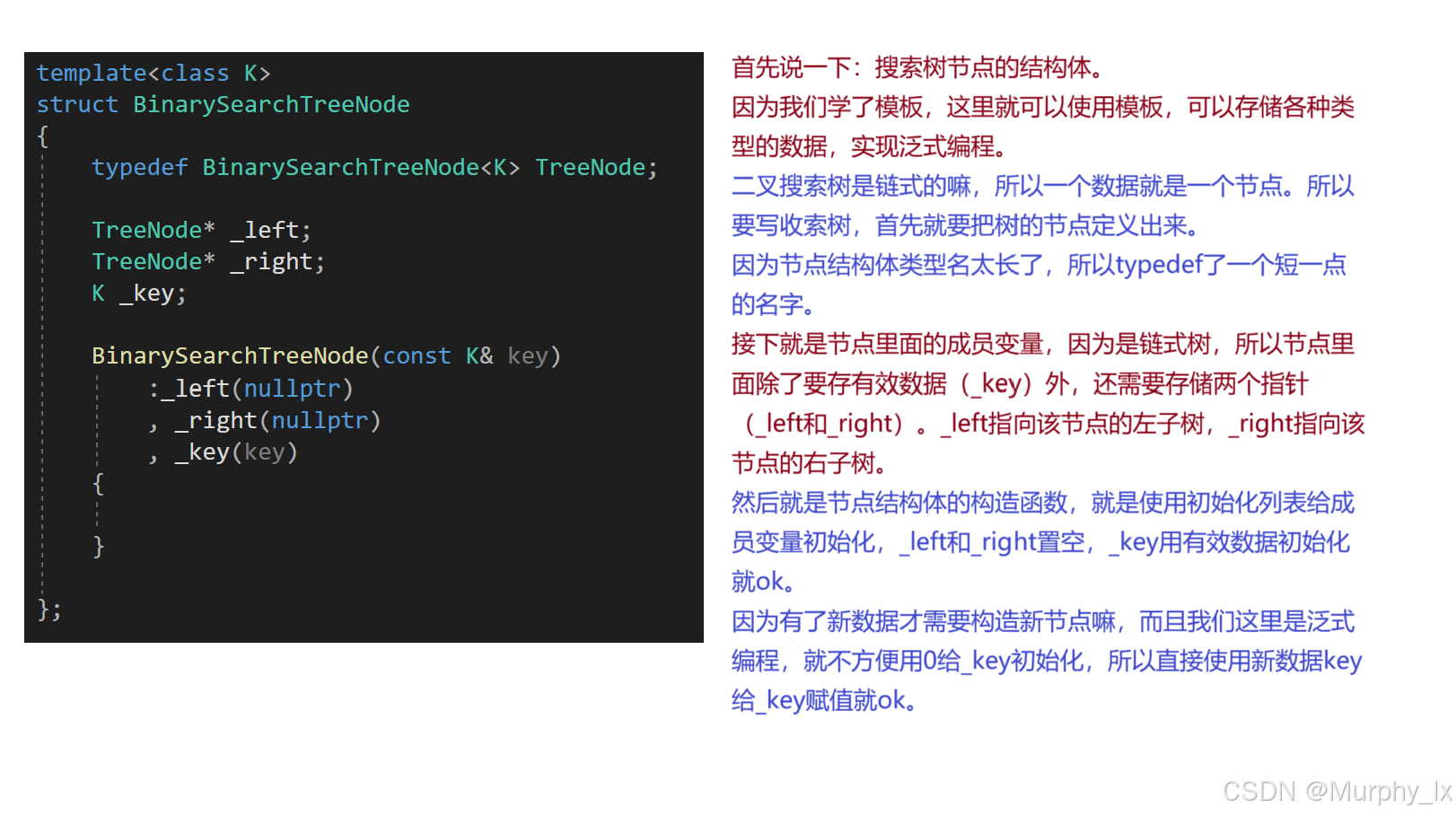
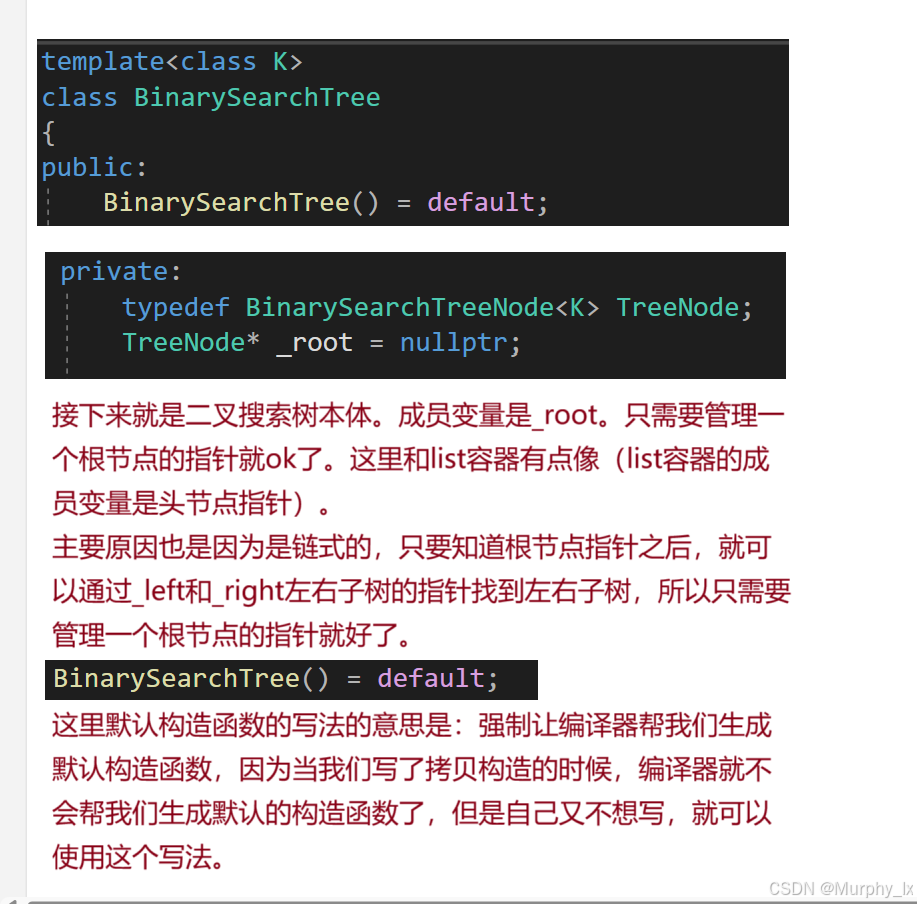
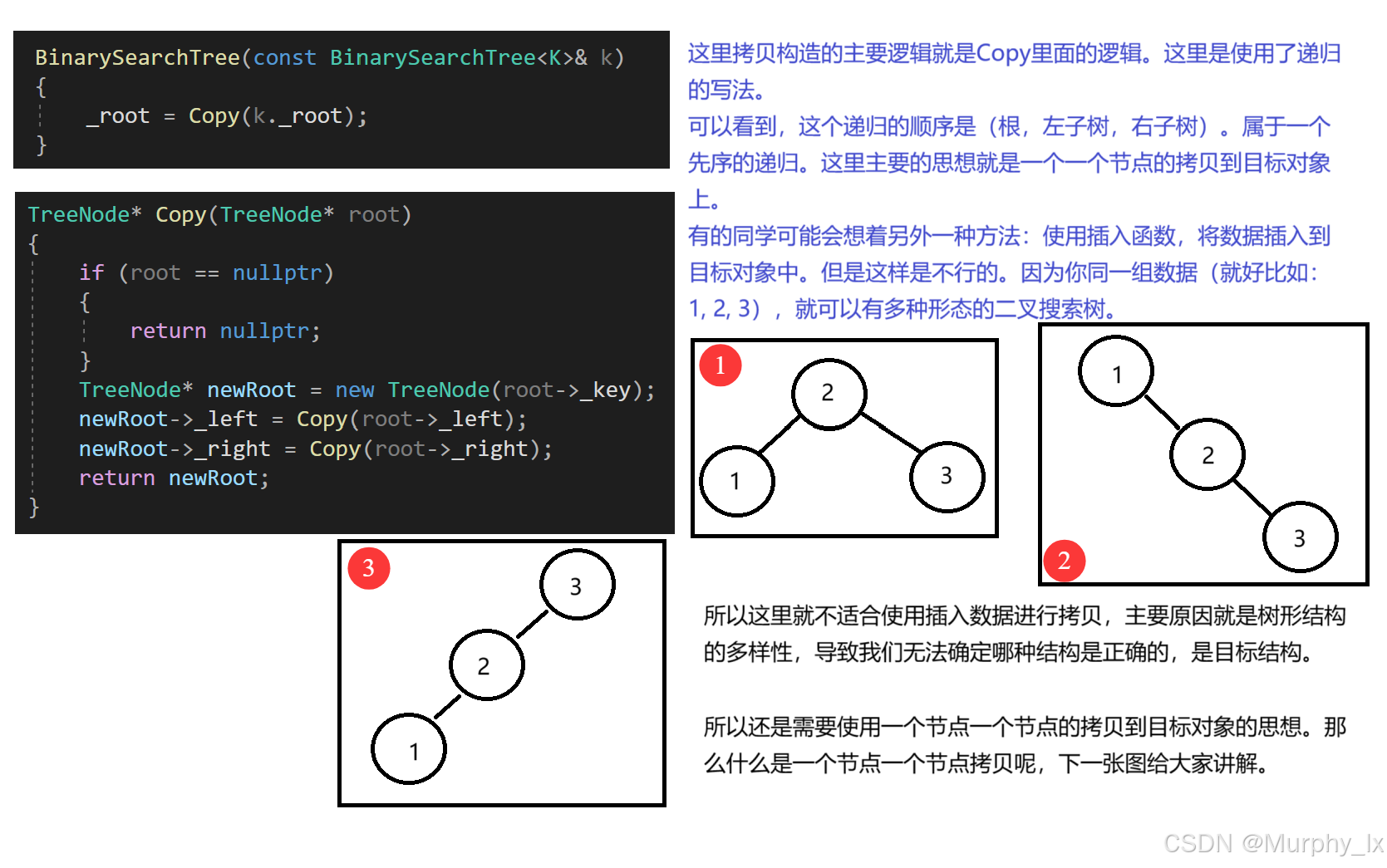
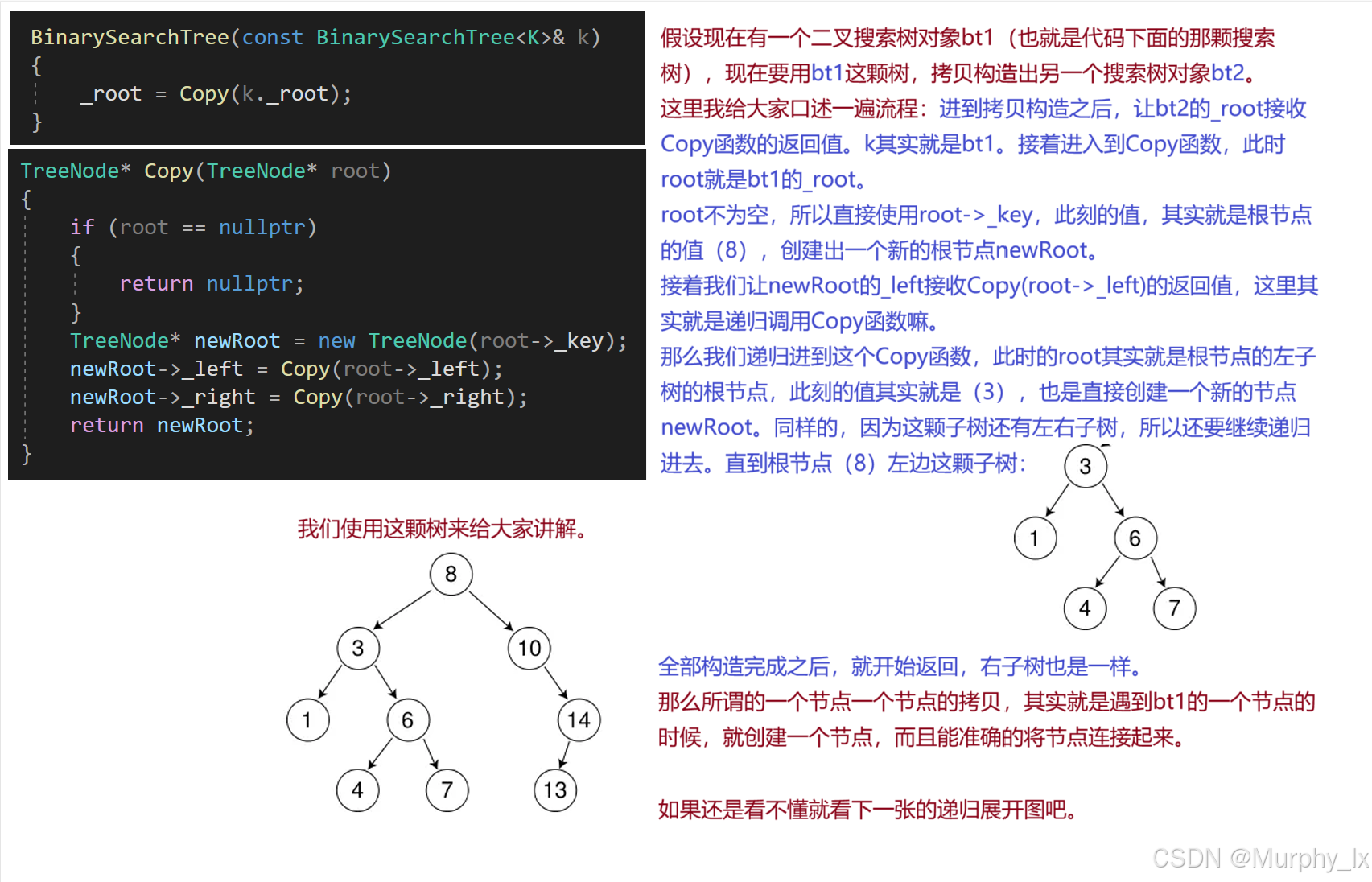

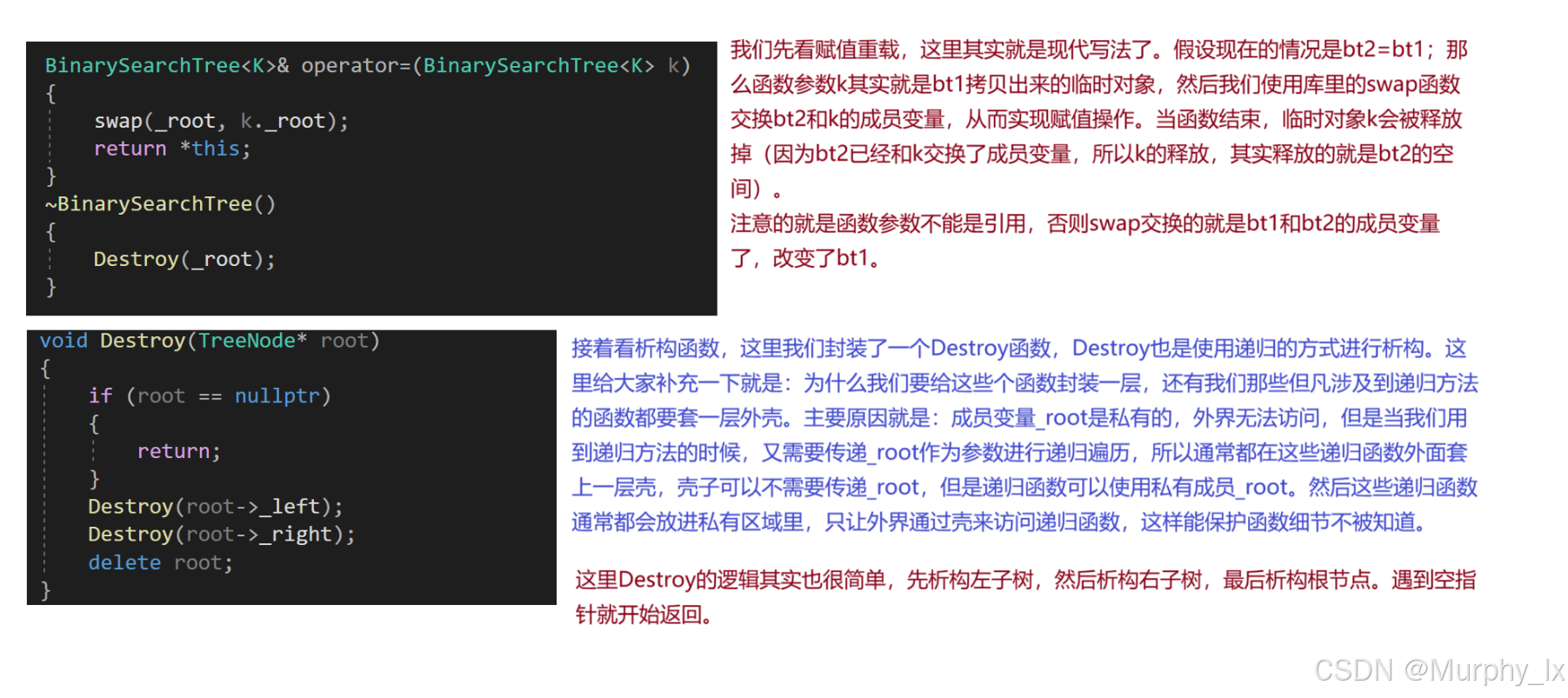
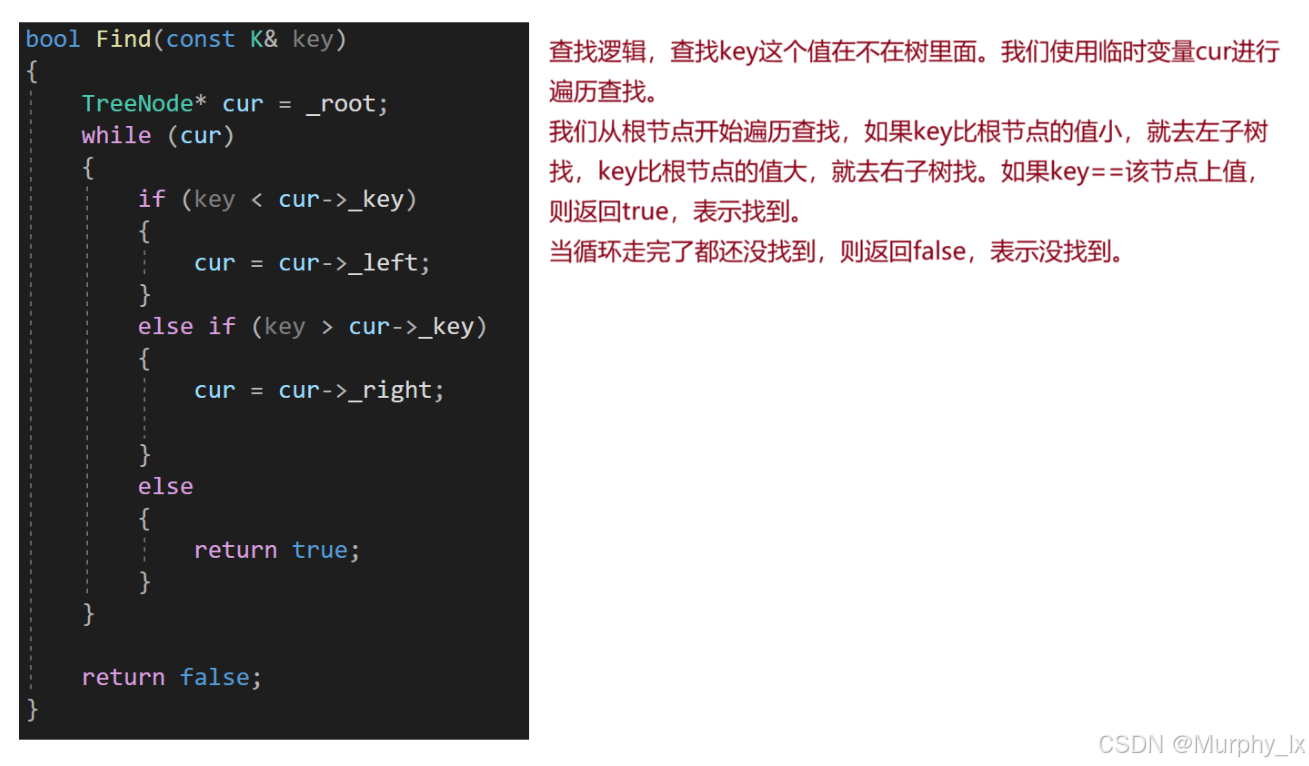
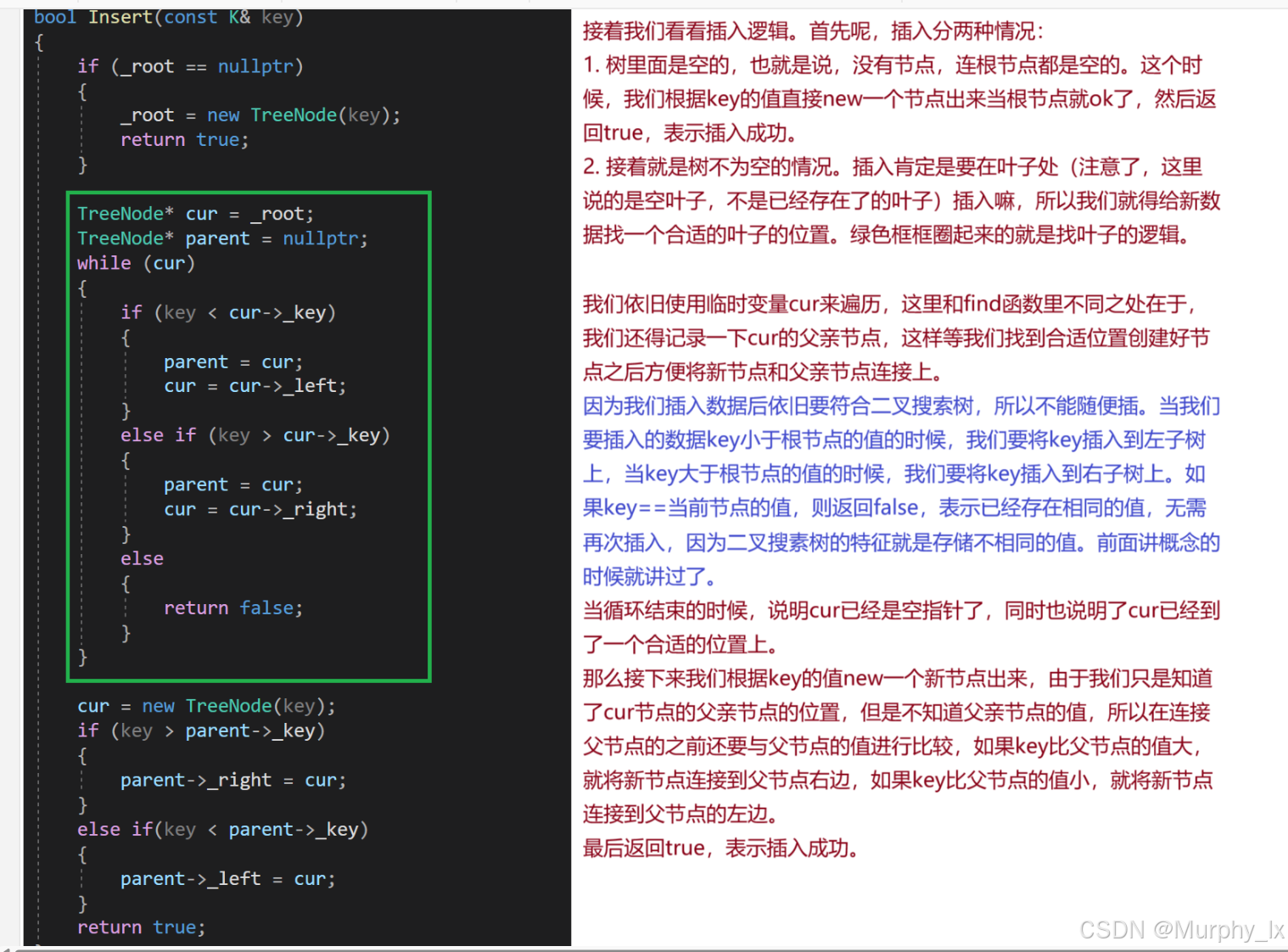
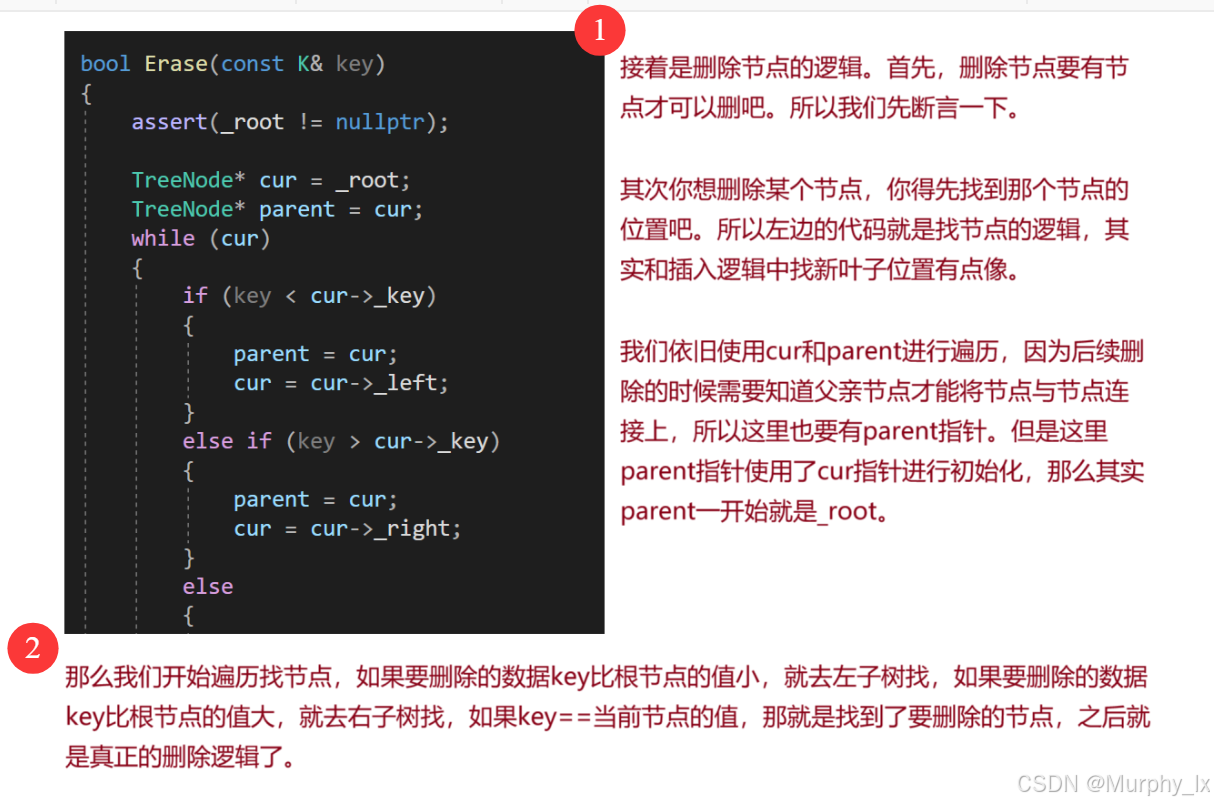
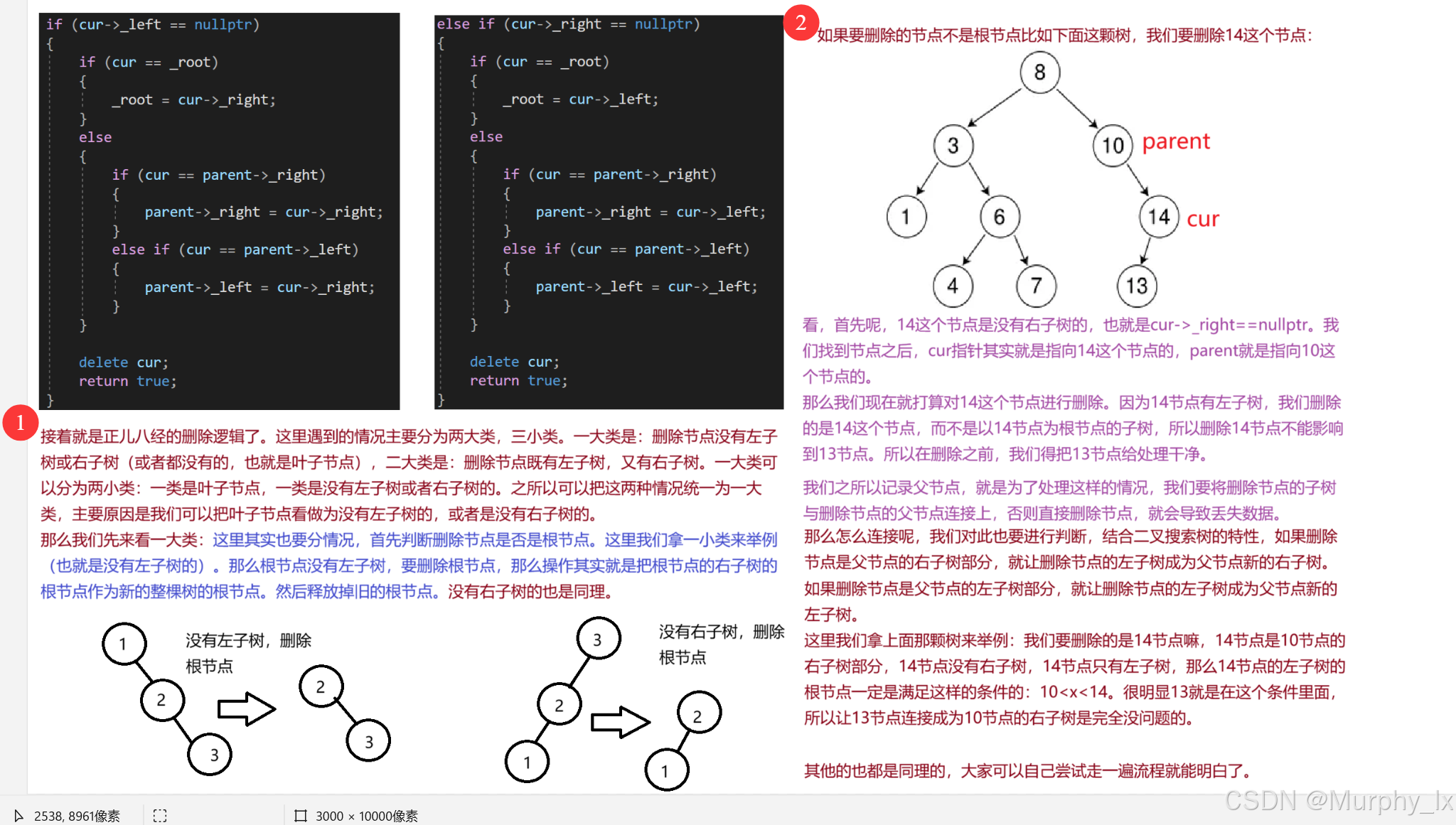
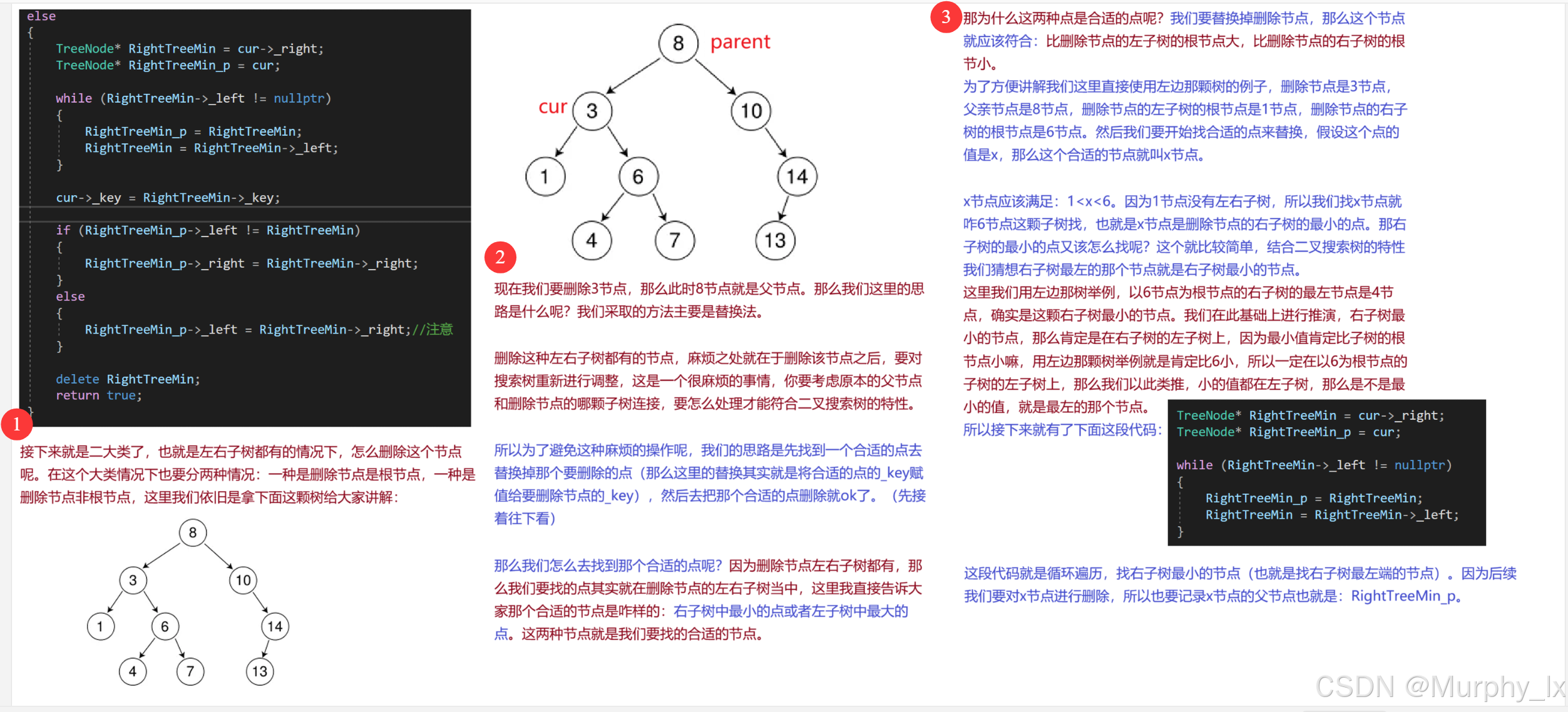
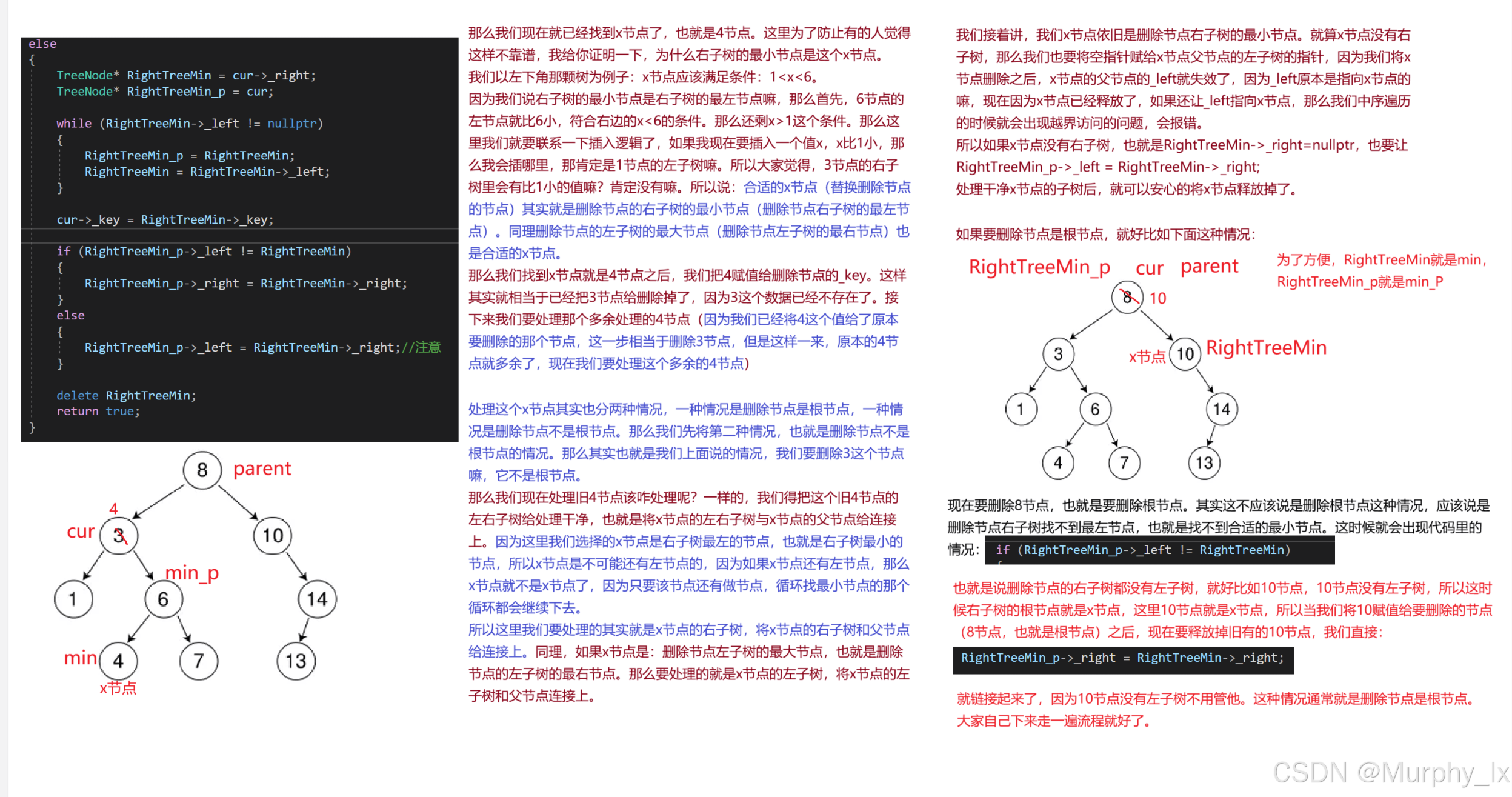
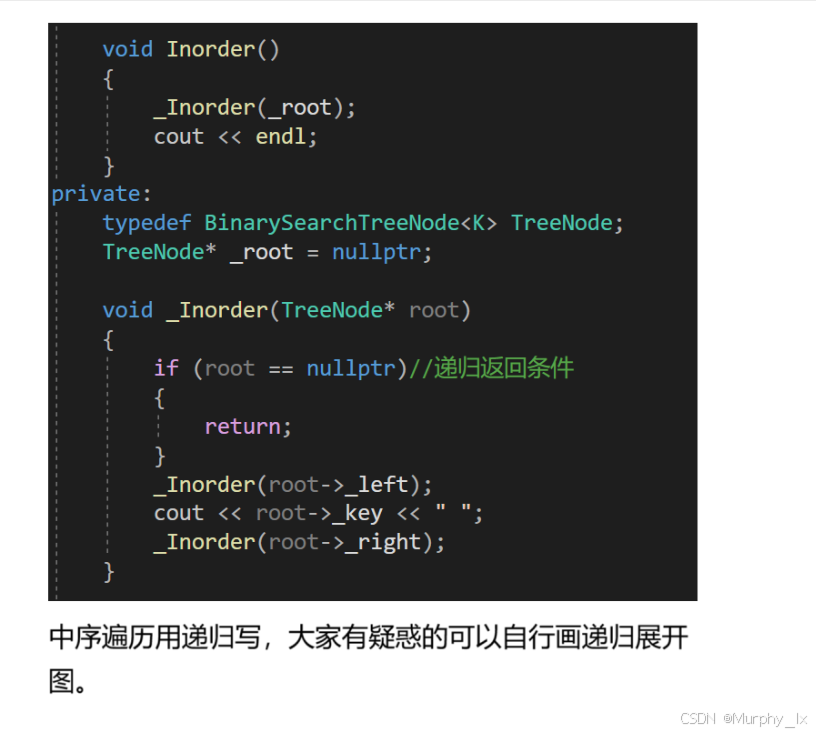
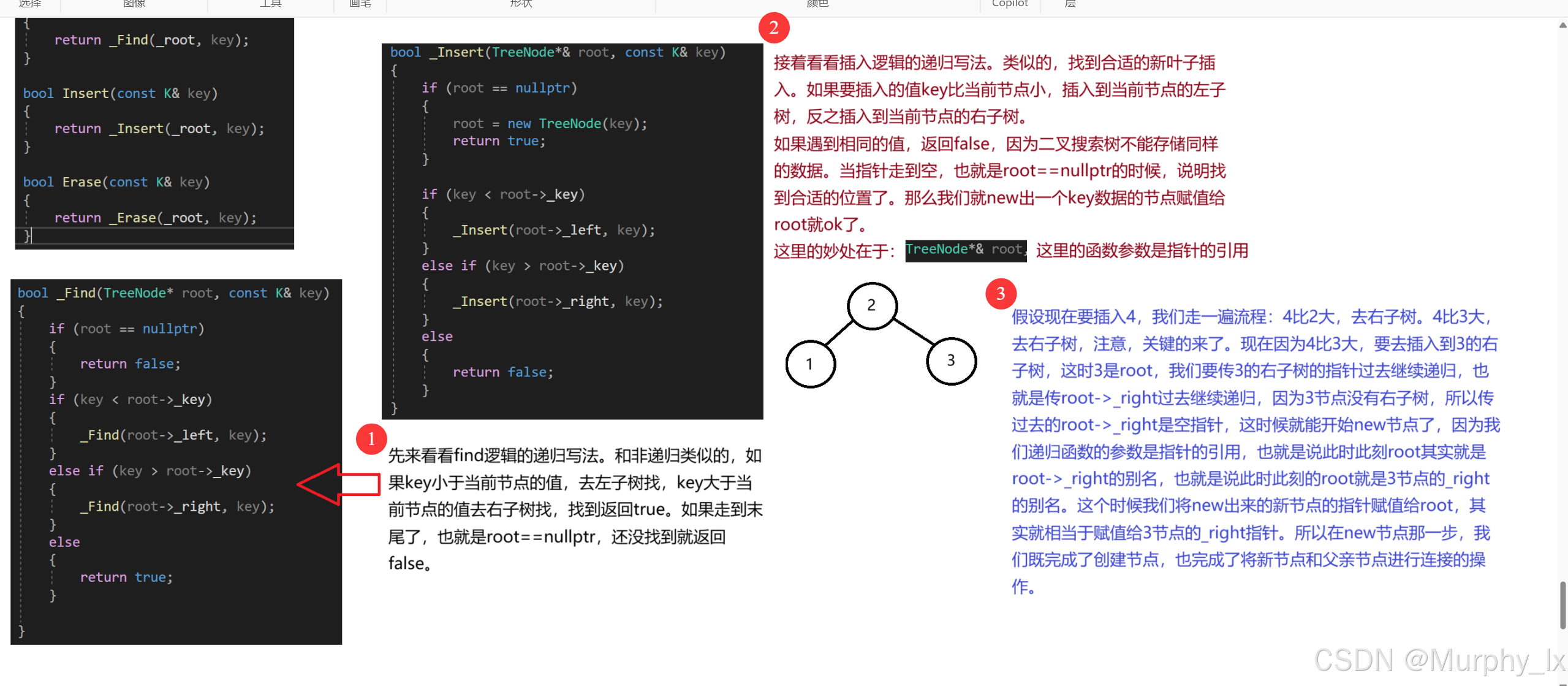
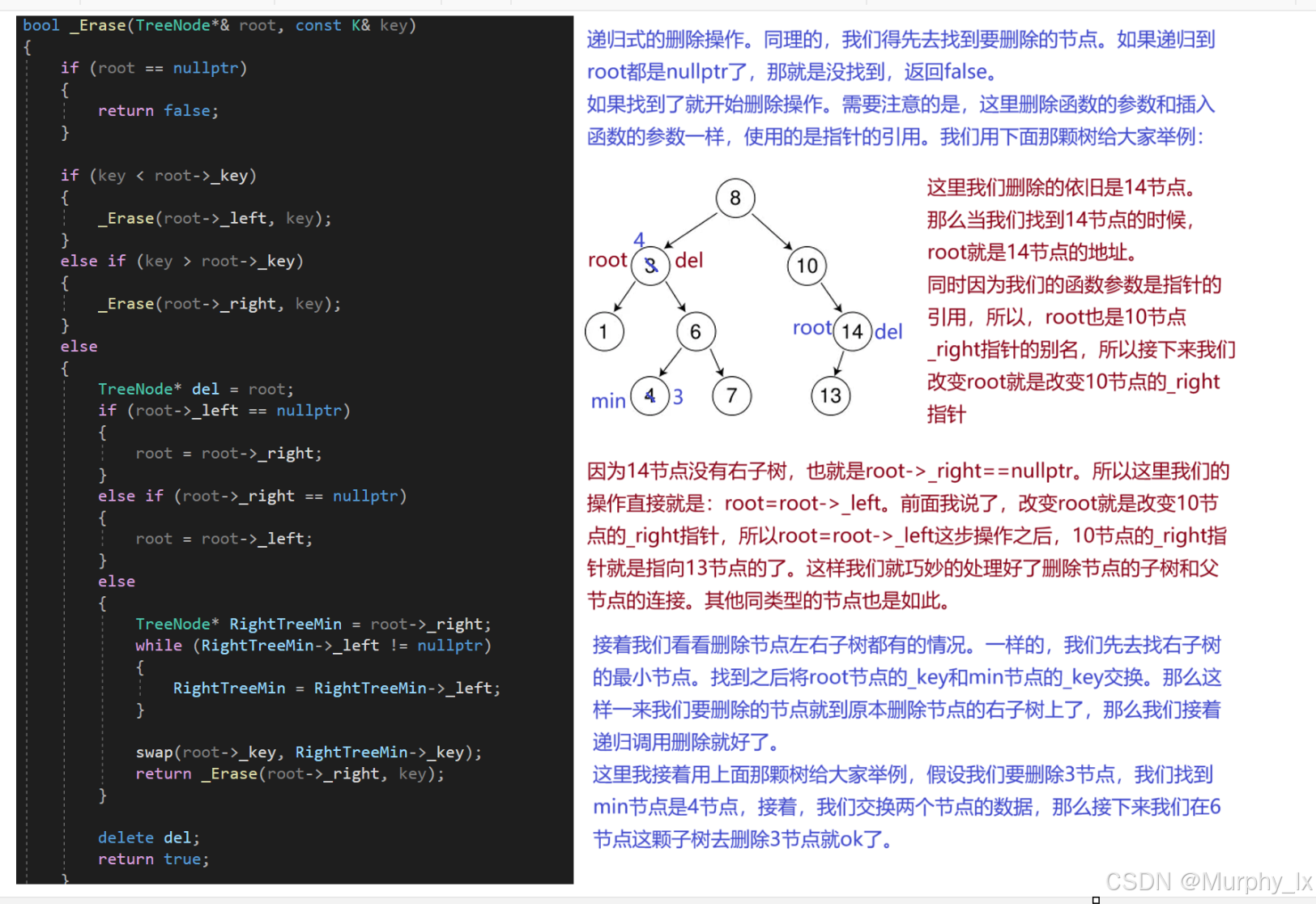
补充
二叉搜索树的应用
- **K模型:K模型即只有key作为关键码,结构中只需要存储Key即可,关键码即为需要搜索到的值。 **
比如:给一个单词word,判断该单词是否拼写正确,具体方式如下:
-
以词库中所有单词集合中的每个单词作为key,构建一棵二叉搜索树
-
在二叉搜索树中检索该单词是否存在,存在则拼写正确,不存在则拼写错误。
- **KV模型:每一个关键码key,都有与之对应的值Value,即<Key,Value>的键值对。**该种方式在现实生活中非常常见:
-
比如英汉词典就是英文与中文的对应关系,通过英文可以快速找到与其对应的中文,英文单词与其对应的中文<Word,Chinese>就构成一种键值对;
-
再比如统计单词次数,统计成功后,给定单词就可快速找到其出现的次数,单词与其出现次数<Word,Count>就是就构成一种键值对。
我们这节写的二叉搜索树的类型就是K模型的。当然了,你想写成KV模型也很简单,我们只需要在树节点的结构体里加上_value成员变量就ok了。其他的什么查找逻辑,插入删除逻辑都是一样的,通过_key找到目标节点之后,就相当于找到了_value。所以没啥不一样的。下面我也给你们贴出部分代码,我就不讲了:
// 改造二叉搜索树为KV结构
template<class K, class V>struct BSTNode{BSTNode(const K& key = K(), const V& value = V()): _pLeft(nullptr) , _pRight(nullptr), _key(key), _Value(value){}BSTNode<T>* _pLeft;BSTNode<T>* _pRight;K _key;V _value};
template<class K, class V>class BSTree{typedef BSTNode<K, V> Node;typedef Node* PNode;public:BSTree(): _pRoot(nullptr){}PNode Find(const K& key);bool Insert(const K& key, const V& value)bool Erase(const K& key)private:PNode _pRoot;};
void TestBSTree3()
{// 输入单词,查找单词对应的中文翻译BSTree<string, string> dict;dict.Insert("string", "字符串");dict.Insert("tree", "树");dict.Insert("left", "左边、剩余");dict.Insert("right", "右边");dict.Insert("sort", "排序");// 插入词库中所有单词string str;while (cin>>str){BSTreeNode<string, string>* ret = dict.Find(str);if (ret == nullptr){cout << "单词拼写错误,词库中没有这个单词:" <<str <<endl;}else{cout << str << "中文翻译:" << ret->_value << endl;}}
}
void TestBSTree4()
{// 统计水果出现的次数string arr[] = { "苹果", "西瓜", "苹果", "西瓜", "苹果", "苹果", "西瓜", "苹果", "香蕉", "苹果", "香蕉" };BSTree<string, int> countTree;for (const auto& str : arr){// 先查找水果在不在搜索树中// 1、不在,说明水果第一次出现,则插入<水果, 1>// 2、在,则查找到的节点中水果对应的次数++//BSTreeNode<string, int>* ret = countTree.Find(str);auto ret = countTree.Find(str);if (ret == NULL){countTree.Insert(str, 1);}else{ret->_value++;}}countTree.InOrder();
}
二叉搜索树的性能分析
插入和删除操作都必须先查找,查找效率代表了二叉搜索树中各个操作的性能。
对有n个结点的二叉搜索树,若每个元素查找的概率相等,则二叉搜索树平均查找长度是结点在二叉搜索树的深度的函数,即结点越深,则比较次数越多。
但对于同一个关键码集合,如果各关键码插入的次序不同,可能得到不同结构的二叉搜索树:

最优情况下,二叉搜索树为完全二叉树(或者接近完全二叉树),其平均比较次数为:log2Nlog_2 Nlog2N
最差情况下,二叉搜索树退化为单支树(或者类似单支),其平均比较次数为:N2\frac{N}{2}2N
问题:如果退化成单支树,二叉搜索树的性能就失去了。那能否进行改进,不论按照什么次序插入关键码,二叉搜索树的性能都能达到最优?那么我们后续章节学习的AVL树和红黑树就可以上场了。
